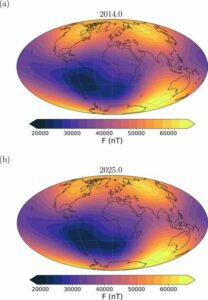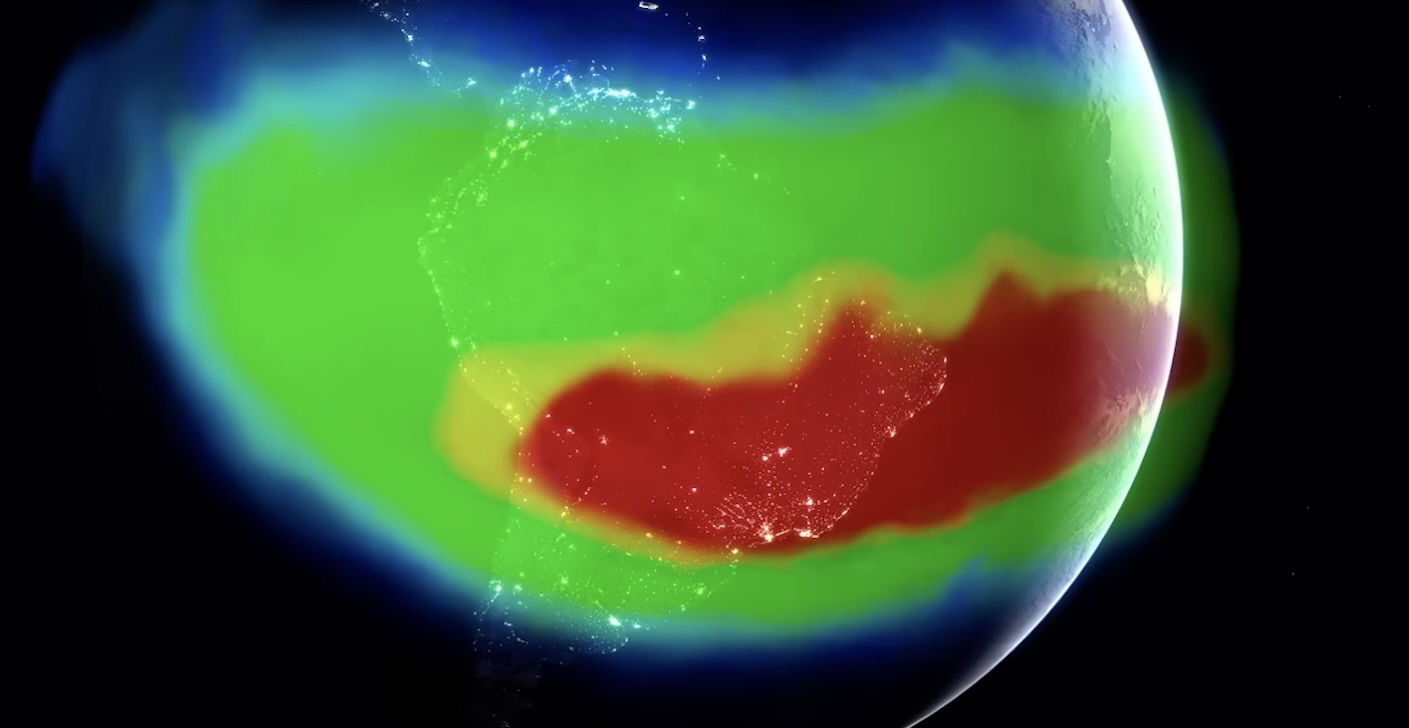A new model of the Earth’s magnetic field, based on data from the European Space Agency’s Swarm satellite constellation, reveals a dynamic shift in the South Atlantic Anomaly that poses severe hazards to essential satellites circling the globe.
The South Atlantic Anomaly, an enormous weak spot in the Earth’s magnetic field, has rapidly expanded in the last decade, potentially subjecting satellites to harmful doses of radiation. That anomaly is not alone, as other regions of the field have experienced notable changes, with some strengthening and others weakening during the same period.
Swarm Constellation
Three identical satellites—Alpha, Bravo, and Charlie—make up the ESA’s Swarm constellation. As part of the ESA’s FutureEO program, the constellation monitors magnetic signals emanating from Earth’s surface, atmosphere, and deep interior. By combining two types of magnetometers with onboard trackers that provide altitude data, the satellites deliver highly precise vector measurements of Earth’s magnetic field.
Since its launch in November 2013, Swarm has produced the longest continuous record of space-based magnetic field measurements ever collected. The mission has far exceeded its original lifetime, proving the effectiveness of its Earth observation technologies. This extended operation has enabled unprecedented long-term data collection, supporting modern global magnetic models and space weather monitoring—processes that typically unfold over long timescales. The resulting data is providing new insight into how different sources of magnetism contribute to the strengthening and weakening of Earth’s field across various regions.
Reconsidering Earth’s Magnetic Field
Using Swarm’s uniquely consistent long-term dataset, a team of researchers has developed an entirely new model of Earth’s magnetic field, presented in a recent paper published in Physics of the Earth and Planetary Interiors. While acknowledging the limitations of relying on a single data source, the team emphasizes that Swarm’s information offers a far clearer picture of our planet’s magnetism than models pieced together from scattered, short-term observations.
Roughly 1,800 miles beneath Earth’s surface, the molten iron in the outer core generates electrical currents that sustain the planet’s magnetic field through complex interactions. At the boundary between the mantle and outer core, the researchers identified unusual features called “reverse flux passages,” which appear to be linked to recent field changes and may be driving them. Additionally, advection—the process by which heat is transported through the molten core—could also play a role in these variations.
One of the primary concerns surrounding such anomalies is their impact on satellites and spacecraft. When orbiting over weak spots, satellites face increased radiation exposure, which can cause malfunctions, damage, or temporary blackouts in onboard systems.
The South Atlantic Anomaly
Since 2014, the South Atlantic Anomaly has expanded by an area roughly half the size of continental Europe. Because Earth’s magnetic field shields the planet from radiation and solar particles, scientists are closely monitoring this development. In addition to tracking the anomaly’s continued growth, the team also found an even more pronounced weakening southwest of Africa, beginning in 2020.
 Between 2014 (a) and 2025 (b), the South Atlantic Anomaly has increased substantially, represented by the growing dark spot on the map. Credit: Wikimedia Commons/C.C. Finlay, C. Kloss, N. Gillet
Between 2014 (a) and 2025 (b), the South Atlantic Anomaly has increased substantially, represented by the growing dark spot on the map. Credit: Wikimedia Commons/C.C. Finlay, C. Kloss, N. Gillet
“The South Atlantic Anomaly is not just a single block,” said lead author Chris Finlay, Professor of Geomagnetism at the Technical University of Denmark. “It’s changing differently towards Africa than it is near South America. There’s something special happening in this region that is causing the field to weaken in a more intense way.”
The story remains dynamic, with several intensely strong regions of the magnetic field acting as counterparts to the weak zones. The team identified one such area in the Southern Hemisphere and two in the Northern Hemisphere—one over Canada and another over Siberia. Over the course of Swarm’s observations, the Siberian region has continued to strengthen, expanding by an area comparable to Greenland, while the Canadian region has shrunk by an area comparable to India. These shifts are associated with the northern magnetic pole’s drift toward Siberia, a trend that holds major implications for navigation.
Keeping an Eye On the South Atlantic Anomaly
“When you’re trying to understand Earth’s magnetic field, it’s important to remember that it’s not just a simple dipole, like a bar magnet,” Professor Finlay said. “It’s only by having satellites like Swarm that we can fully map this structure and see it changing.”
Swarm’s ability to monitor Earth’s magnetic field is expected to continue into the next decade. With humanity’s growing reliance on satellite infrastructure, maintaining their safe operation is critical to daily life. The Swarm team aims to keep providing data essential to understanding the hazards of near-Earth space.
“It’s really wonderful to see the big picture of our dynamic Earth thanks to Swarm’s extended timeseries,” Said Anja Stromme, ESA’s Swarm Mission Manager. “The satellites are all healthy and providing excellent data, so we can hopefully extend that record beyond 2030, when the solar minimum will allow more unprecedented insights into our planet.”
The paper, “Core Field Changes from Eleven Years of Swarm Satellite Observations,” appeared in Physics of the Earth and Planetary Interiors on October 3, 2025.
Ryan Whalen covers science and technology for The Debrief. He holds an MA in History and a Master of Library and Information Science with a certificate in Data Science. He can be contacted at ryan@thedebrief.org, and follow him on Twitter @mdntwvlf.


